Thu 16 Dec 2010
by Marvin Lachman
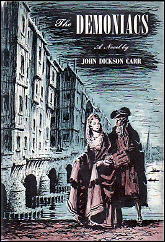
Vol. 11, No. 4, Fall 1989.
… Carroll & Graf has also reprinted John Dickson Carr’s historical mystery, The Demoniacs (1962). This is not top-class Carr; the murder method is unconvincing, and there are too few suspects. Also, many characters are given the annoying habit of answering questions with questions.
Still, London in 1757 comes remarkably alive, and we learn a great deal about the famous mercenary thief-takers of the time, through the hero, Jeffrey Wynne, “the only honest Bow St. Runner.” Also interesting is Carr’s description of a massage parlor, written a few years before they became so popular in the sleazy areas of our cities.
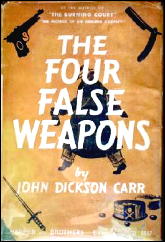
Proof of Carr’s popularity is that two other publishers are also reprinting his work. Harper’s Perennial Library has just issued four books, and only one is in any way weak.
The Four False Weapons (1937) is the last and weakest of Carr’s Henri Bencolin series, and it could have used a less muddled solution, as well as a diagram of the hard-to-picture murder house. The characters and their emotional responses are so implausible they prove distracting.
However, Carr is at or close to his best in the three Gideon Fell books from Perennial. The Mad Hatter Mystery (1933) is chronologically the second Fell book, and who can resist its bizarre plot, with top hats being stolen all over London?
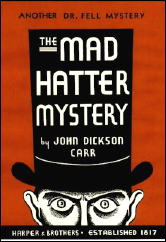
One hat turns up on the head of a corpse found in the Tower of London, a building whose physical aspects are important to the plot. The book is also about an unknown Poe manuscript which supposedly predates “Murders in the Rue Morgue.”
Carr even provides this poignant description of the unhappy Poe: “Never in his life would that dark man have anything, but dreams to exchange at last for the cold coin of an immortal name.”
Long ago in these pages (Vol. 2, No.3, May 1978), I wrote an article about Carr in which I described how he usually had a character who embodied much of his own history and traits and acted as Watson to Dr. Fell’s Holmes.
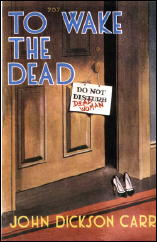
Christopher Kent in another Perennial reprint, To Wake the Dead (1938), is one of Carr’s most appealing of these secondary players, a mystery writer who finds a corpse in a London hotel who turns out to be his cousin’s wife. So strong are Carr’s narrative powers in this book that we accept coincidences we might not take from lesser suspense writers.
The Case of the Constant Suicides (1941) is one of the three best Fell books, high praise indeed. (The very best of the Fells, The Crooked Hinge [1938], was reprinted by Perennial in the summer of 1989 and is still available.)
Constant Suicide’s hero is, like Carr, an American in the British Isles. Alan Campbell’s train journey to Scotland, in which he meets an attractive, mysterious woman (also named Campbell), is a near perfect beginning. The setting, a castle in the Highlands, and the intricate murder puzzle also could hardly be improved upon.
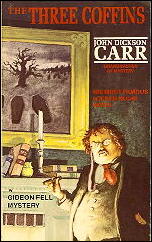
IPL has no fewer than twenty Carrs in print, including nine as Carter Dickson, and I am tempted to take the easy road and merely recommend all of them. Well, I do recommend them all, but I will select some favorites among them:
Seldom have atmosphere and puzzle been more happily married in a mystery than in Hag’s Nook (1933), the first and one of my three favorite Fells. The Three Coffins (1935) is arguably Carr’s most famous book, and because of its famous lecture chapter is probably the seminal work on locked rooms. Though Barzun and Taylor detested it, the exotic Below Suspicion (1949) is one of the best of the “later” Carrs.
It may be sacrilege, but in general I prefer the books Carr wrote as Dickson. The puzzles were as good, and Carr wrote some hilarious scenes of slapstick, usually for the entrance upon the scene of the “Old Man,” as his detective, Sir Henry Merrivale, calls himself.
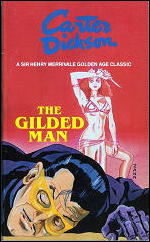
In He Wouldn’t Kill Patience (1944), my favorite of all Carr’s seventy-plus books, we meet him being chased around the reptile house by a large tropical lizard. This ingenious “locked zoo” mystery is enhanced by a cast of magicians — and the background of London blacked out in the “blitz.”
In The Reader Is Warned (1939) Merrivale solves a murder with impossible elements, though not in a locked room. We also have Merrivale driving a train and hitting a cow. Why is HM driving a train and how did the beast get on the tracks? That’s a bonus to the mystery, if you read the book.
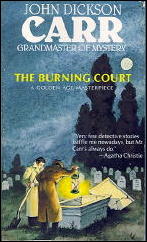
The Gilded Man (1942) is one of the most enjoyable weekend-house-party mysteries ever written. Besides a wild and wickedly clever puzzle, there is Merrivale, as a substitute magician and mixing axioms. “The cat’s been at the spilt milk. There’s none left to weep over.”
One more Carr from IPL must be mentioned, a non-series entry, the justly famous The Burning Court (1937). Ordinarily, when an author introduces elements of the supernatural into a mystery, I shout “Cop-out” and throw the book aside. Carr not only does it in this book, along with some non-science-fictional time travel, but he had me eating out of his literary hand and loving it.
December 17th, 2010 at 9:28 am
I read every book he wrote a million years ago. He was always a lot of fun.
December 17th, 2010 at 12:06 pm
I suggested this comprehensive overview of Carr’s detective fiction for this week’s of your Forgotten Friday books, Patti, not so much because he’s been forgotten — some of his books have recently been reprinted by Rue Morgue Press, for example — but for the general mystery reading public, I think he falls into the category of a moldy oldie.
An author you’ve heard about, for example, if you’re under a certain age, but when (if) you picked up one of his novels to read, you found him old-fashioned, overwritten and/or boring.
Nonsense, I say, but so it goes. Without Ellery Queen’s Mystery Magazine still around, and maybe the Jim Hutton TV show recently out on DVD, I think Ellery Queen would be equally forgotten, or on the verge.
I also read John Dickson Carr a million years ago — we’re not speaking literally here, are we, Patti? — and I agree. He was good fun then, and maybe he’s even better fun now. (You often view books differently a second time around. Books don’t change, but you do.)
December 17th, 2010 at 2:23 pm
I must say that my favourite of Carr’s detectives is Merrivale. He’s just such a life affirming character that you simply enjoy being in his company, even if he’s causing chaos rather than detecting.
Some of the books here are ones that I’ve read; others are ones that I’m going to read. CONSTANT SUICIDES is a goody. I remember causing an argument between some scientifically qualified people of my acquaintance as to whether the murder method was physically possible. After much debate it got a qualified yes, but only if certain conditions were adhered to.
I think that I’ve enjoyed every one of Carr’s books that I’ve read. Some I liked better than others, but all of them had something that gave me pleasure.
December 17th, 2010 at 2:34 pm
Long live Carr! No need for me to laud him any further than I have here and elsewhere.
Steve –
Coincidence that you should mention the Jim Hutton “Ellery Queen” TV shows. I added them to my Netflix queue and started watching them one after the other over the past few weeks. (They were available in bootleg versions for years, but I always avoid those since my low tech DVD player never could read/play them! I wasted a bit of cash on a few hard to find movies before I discovered this.) And here is a perfect example of one’s veil of nostalgia quickly ripped from one’s eyes suddenly to reveal reality. I loved these when I was a teenager but now find them typical of 1970s TV which is to say pretty darn mediocre. They are heavily padded with banter and 1950s style gags (were the writers – apart from Levinson/Link – veterans of the early days of TV?). Most of the mysteries were very weakly constructed with the detective work emphasized in rushed Q&A sessions and little examination of physical evidence. I think only three of the shows came from actual Queen stories. The pilot is an uncredited rewrite of FOURTH SIDE OF THE TRIANGLE one of those ghost written novels. Hutton was so likable in his absent-minded portrayal of Queen and David Wayne, that stalwart actor from the Broadway stage, was a great foil as his Dad. I liked the addition of 40s era actors playing small parts: Ida Lupino as a terrified victim, Donald O’Connor as a milquetoast comic book artist, Ray Milland & Kim Hunter as husband & wife in the original pilot, etc. If only the producers had found gifted actors like Geraldine Brooks who no doubt was paying homage to her own early career in films like “Cry Wolf” and “Possessed.” She did a spot on 40s style characterization from her rapid fire line delivery to her quirky physicality in performing her role as an embittered housekeeper in “The Chinese Dog.” With casts of actors like Brooks, and directors who really understood the 40s feel, the series really could have been a brilliant homage to the era and perhaps been a long running success. Sadly, viewing it today with a more sophisticated adult taste I found most of the acting uninspired and humorless or grating and annoying like Ken Spofford as the brash newspaper columnist who screams his way through all his scenes doing a weak impression of some minor character who escaped from “The Front Page.”
December 17th, 2010 at 3:47 pm
Carr was the first mystery writer I found that I really enjoyed after I had read all the Agatha Christie twenty years ago. I prefer the Merrivales too. Dr. Fell just seems like a pompous windbag to me, though some of his mysteries, like The Crooked Hinge, and The Three Coffins are classics.
But it’s like Doug Greene says, he is one of those mystery writers who seems to perform miracles. That’s a rare, remarkable quality–and it should never go out of fasion. An age that cannot appreciate Carr is a tarnished and austere one indeed.
December 17th, 2010 at 4:27 pm
John
Regarding your comment #4 and the Jim Hutton-EQ TV series, I’m going to change my concluding statement in comment #2 completely around and say “You often view books (TV shows) differently a second time around. Books (TV shows) don’t change, but you do.”
Another side of the coin, to coin a phrase.
So far I’ve watched one of the EQ series, the one that takes place on New Year’s Eve, and that was from a bootleg set. My brother just sent me the official release for Christmas, so I can’t watch it now. I have just over a week before I can.
I enjoyed the one I watched, but differently than when I saw it for the first time. I enjoyed the performances and the story, but I had quibbles about the solution and was aware of the same kinds of flaws you did, I’m sure, and sometimes acutely so.
You can’t go home again. Some things improve, others don’t. As time goes on,the only constant is that things change.
Earlier this year I re-read THE BLIND BARBER for the first time in probably 40 or 50 years. Didn’t remember it at all. I saw some flaws (Carr’s sense of farce is not always the same as mine), but I enjoyed the trickery immensely. He fooled me again, he did.
— Steve
December 17th, 2010 at 5:05 pm
The only Carr I’ve read was his stuff in The Exploits of Sherlock Holmes, but it was good stuff. Be interesting to see his take on the Bow Street Runners.
December 17th, 2010 at 5:15 pm
I loved the show as a kid, and watching the recent BBC repeats I found that I loved it even more. The regulars were perfect, and the guest cast generally well chosen. The scripts were variable, but the best were very good indeed, and even the worst had a lot to recommend them. Speaking personally, I really enjoyed Ken Spofford’s caricature reporter. The episode where he suffers from the ultimate in first night TV nerves is priceless.
December 17th, 2010 at 5:49 pm
There’s a brilliant mystery in The Blind Barber, though I wanted someone to push the Swedish (?) ship captain overboard. KA-ROOSH!!!!